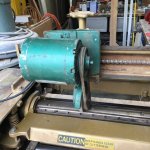Bill D
Diamond
- Joined
- Apr 1, 2004
- Location
- Modesto, CA USA
I just bought a powermatic 180 18" planer. It has the grinder bar and carriage attached but no grinder. Then grinder gets hinged and attached to the carriage to allow it to move in and out to adjust depth of the grind.
I am trying to come up with a way to mount a tool post grinder. I do not think the spindle accuracy is as important as in metal work. In wood working 1/1000 is the best possible.
Bill D
I am trying to come up with a way to mount a tool post grinder. I do not think the spindle accuracy is as important as in metal work. In wood working 1/1000 is the best possible.
Bill D






